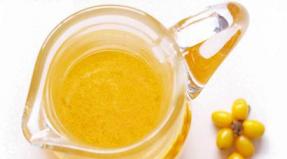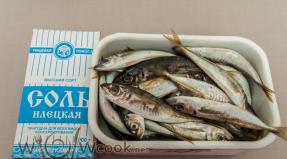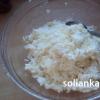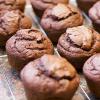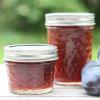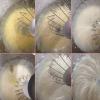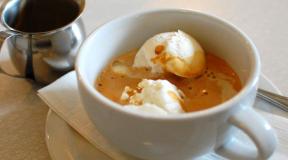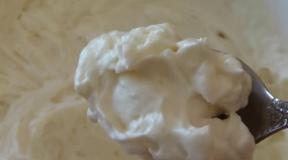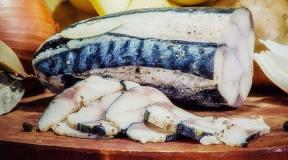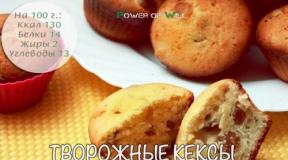What a soft cheese delicious but not fatty. Low-fat cheese
If you are using any diet for weight loss or simply strive to eat right, you should not eat only low-fat foods, after all.
The only thing you need to choose foods with a low percentage of fat, they are less high in calories. The list below will help you with this - a list of low-fat cheese varieties.
As you know, cheese is a useful, easily digestible product, it contains a lot of protein for the structure of muscle tissues (more than in fish or meat), calcium, zinc, phosphorus, vitamins E, C, A, D, PP, group B.
However, it is necessary to distinguish between low-fat and fatty cheeses. Most of the cheeses we are used to have a fat content of 50-70% (50-70 grams of fat per 100 grams of product). The task of a person who monitors his appearance and figure is to consume cheeses up to a maximum of 30% fat.
Low-fat cheeses and their calorie content
First on our list is soy cheese tofu... This cheese has a fat content of 1.5 to 4%. It is high in quantity and is an alternative to meat protein. The calorie content of this cheese is 80 kcal per 100 grams. Ideal as a snack sandwiches and as a valuable ingredient in salads.
Ricotta cheese It is not made from skim milk, as many believe, but from whey that remains during the preparation of other types of cheese. Its fat content is 8-13%, and its calorie content is 174 kcal. Contains, in addition to calcium, vitamins A and B group, the essential amino acid methionine - the most important amino acid for the liver. This cheese is often used in the form of salads, desserts and as an independent snack.
Mozzarella also made from skim milk. It is usually sold in the form of balls in a saline solution. Fat contains 22.5%, calories 149-240, depending on the type of mozzarella.
(grain cheese) looks like grains of cottage cheese cooked in salted fresh cream, its fat content is no more than 5%, calorie content is up to 125 kcal. It is used in salads and is also used as an independent dish. It is also often called homemade or country cheese (in the West, cottage cheese).
Chechil cheese also refers to low-fat cheese (only 5-10%). This cheese resembles Suluguni in consistency. It is produced in the form of fibrous dense threads, which are twisted in the form of a pigtail. Contains a large amount of salt, as it matures in a saline solution, it is often sold smoked. Contains 313kcal.
Low-fat cheeses Valio Polar, Fitness, Grunlander contain about 148 kcal with a fat content of only 5-10%. You only have to look for them in expensive supermarkets or hypermarkets. And read the packaging, some of them may not contain 5% fat, but 5% yogurt.
Feta or light cheese. Many consider feta cheese a dietary product, love it in salads, especially in Greek, however, the calorie content of ordinary feta cheese is 250 kcal with a high percentage of fat. An alternative has appeared in stores: feta-light (light cheese), its fat content is from 5 to 17%, the calorie content is on average 160 kcal.
Low-fat cheese Arla, Natura and Valio, Oltermanni... It tastes like fresh milk, an excellent product for those who are trying to eat right and maintain their figure. The calorie content of such cheeses is 210-270 kcal and 16-17% fat. 
 Cheese Valio, Oltermanni
Cheese Valio, Oltermanni
Suluguni is a Georgian pickled cheese. Its fat content is 24%, calorie content is 285 kcal.
I think that in this list of low-fat varieties of cheese, you can choose for yourself "your" cheese, which will satisfy you both in taste and in the usefulness that it will have on your body.
Bon Appetit!
Cheese is the oldest natural product produced by man from the very beginning of history. Cheese has been appreciated at all times: as a satisfying product for every day, and as a delicacy. In this article, we'll take a look at the leanest cheese varieties. And also, let's talk about the calorie content of the most common types of cheese.
1. Low-fat cheese - Tofu... This is soy cheese. Its fat content ranges from 1.5 to 4%. In terms of its content, tofu is rich in high-quality proteins, so this cheese can be a good substitute for meat. In addition, there are only 80 calories in 100 grams of tofu cheese. Therefore, tofu is recommended to be included in the fitness menu.
2. Low-fat cheese - cottage cheese(fat content 5%). In the USA and European countries (and not only English-speaking ones), cottage cheese is called cottage cheese (English village or cottage cheese). Calorie content of cottage cheese: 98-125 kcal. The lowest-calorie one produced in Russia is grained cottage cheese “Savushkin product“ 101 grains + cream ”BIO 5%. Its calorie content: 98.6 Kcal.
3. Low-fat cheese - from skim milk (8%). The calorie content of this cheese is 140 kcal.
4. Low-fat cheese - Kaluga "Chechil", gourmet smoked, rope. Its fat content is 10%, and its calorie content is 140 kcal.
6. Low-fat cheese - Viola Polar, Grunlander, Fitness (5-10%), calories: 148 kcal
7. Low-fat cheese - Chechil(fat content 5-10%). - fibrous pickled cheese, the consistency resembles suluguni. It is produced in the form of dense, fibrous threads, twisted into tight braids in the form of a pigtail, often smoked. It contains up to 10% fat, moisture - no more than 60%, salt - 4-8%. With a fat content of 5%, the calorie content is 155 kcal.

8. Low-fat cheese - Feta Arla Apetina... Apetina in traditional packaging - the cheese has a slightly salty taste and delicate texture. Perfect for making salads or as a snack with any kind of bread. Nutritional value: proteins 15.0 g, carbohydrates 5.0 g, fats 8.5 g. Caloric content: 160 kcal.
The taste of ricotta is slightly sweet, not sour, but rather bland. Ricotta comes in different fat contents. It can be made not only from whey, but from cream or milk (better still, from fatty milk). As a type of Italian cheese, ricotta is practically not common in our country, as, for example, mozzarella or parmigiano.
However, in his homeland, he does not at all graze the rear in the knowledge. This amazing dairy product is suitable for most diets due to its low fat content and easy absorption by the human body. Compared to other cheeses, ricotta is much lower in fat and calories. Its most famous varieties are: ricotta romano, ricotta piemontese, ricotta siciliano, etc., depending on the density: ricotta molitheor (salted), ricotta forte (soft, not aged), ricotta dolce (fresh, without salt). In cooking, ricotta is widely used as a dessert. Neapolitan pie (pastira) as well as Sicilian pastries (cassata or cannoli) are the most common ricotta desserts. Also, it is present in pancakes, pies, various cakes. However, ricotta is used for cooking not only sweet dishes.
Calories: Ricotta from skim milk -138 kcal, fat - 8%, Ricotta from whole milk - 174 kcal, fat - 13%
Pickled cheeses Their average caloric content is 250 kcal.
Suluguni is a Georgian cheese with a pronounced sour milk, slightly salty taste and smell. The consistency is dense and elastic. prepared from pasteurized cow's milk, goat's, sheep's or buffalo's or their mixture. Calories - 286, fats 22%.
Cheese feta or - this is the most popular cheese in Greece. But its popularity is no longer limited to Greece, this sheep's cheese is known all over the world. We know it as an unused attribute of Greek salad. According to the cheese classification, it is classified as a soft variety. "Feta" in translation from Greek means "piece". By the way, this is due to the fact that it is made in a rather large piece. Feta is a bit like young pressed cottage cheese, but the taste of the cheese is very rich, with mild sourness and a little salty. This is a rather fatty cheese (50%), so for those who keep an eye on their extra pounds, it will not work. Feta cheese should be eaten with pleasure, without thinking about how many calories it brings to the body. This cheese was prepared in the days of Homer. Calorie content of cheese, feta: 260-270 kcal
Processed cheese
Milkana fresh cream cheese 65% - Calories: 239 kcal
Fresh President cheese with garlic and herbs 70% - Calories: 344 kcal
Almette cheese curd with herbs Fat content not less than 60-70% - Caloric content: 266 kcal
Cream cheese Rama Creme Bonjour natural curd 27% - Calories: 280 kcal
Cream cheese Rama Creme Bonjour curd with pieces of fresh herbs 26.7% - Calories: 277 kcal
Some types of cheese are more acceptable for fitness nutrition, others less, but in any case, this is an extremely healthy and nutritious product recommended by many nutritionists and its value for a person actively involved in fitness is undeniable.
Therefore, today we will talk about cheeses, their differences and the advantages of one type over another in the fitness nutrition system.
Hard cheeses
Edam... In our country, it is very common under the name Dutch cheese... Its closest relative is cheese Gouda... They are both hard sliced varieties. The taste of Edam cheese is slightly nutty, and the aroma is stronger the more mature the cheese is. Edam cheese is made in many countries of the world, it is so popular. This variety is perfect for fitness nutrition, as it is relatively low in fat (28%) and, at the same time, is very rich in protein (25%). The total calorie content is 352 kcal. Edam cheese is a wonderful breakfast and dessert.
Cheddar cheese a truly English hard cheese. Cheddar ripens from 60-180 days, sometimes even more, has a slightly sour nutty taste. This variety is one of the most produced in the world. It is slightly fatter than Edam cheese in 100 grams of cheddar - 32 grams of fat, protein - 23 grams, while the calorie content is 392 kcal.
Munster hard cheese originally from France. Its fat content is not as high as that of Cheddar and is 29 grams per hundred grams, while proteins, on the contrary, are more than 26 grams. Caloric content 365 kcal. Similar in taste and nutritional properties are cheeses such as limbour, livaro, romadur and tilsiter.
Emmental cheese, this hard Swiss cheese, is very popular not only in Switzerland, but also in Germany, where it is often called Algaussky... It is also produced in France, Austria and Finland. The fat content of this cheese is 31 grams, the amount of protein per 100 grams of the product is 29 grams.
Parmesan this is the king of all cheeses. In Italy, the homeland of this type of cheese, several of its varieties are made. Parmesan is the hardest of all hard cheeses, while it is not yet fatty - 32% fat in dry matter. This cheese ripens for up to 10 years and sometimes even more. Moreover, according to experts, over the years it only gets better and harder. There comes a time when such a cheese head can only be split with a hammer. Of course, not all the cheese that you see on the shelves matures for 10 years, usually the maturation period for Parmesan is 3-4 years. Parmesan is almost always used grated. By the way, at the exit from the cellar, the cheese head is tapped with special hammers in order to determine whether the cheese is "healthy" or not. By the way, if any violation is found, then this cheese goes to rejection. They grind it and sell it already grated and prepackaged. So remember that freshly grated Parmesan cheese is no match for prepackaged grated and dried cheese. 100 grams of cheese contains fats - 28 grams, proteins - 33, total calories - 292 kcal.
Gruyere is also a very hard Swiss cheese, but slightly fatter than Parmesan. Fat - 31 grams, protein - 27 grams, total calorie content: one hundred grams of the product contains 396 kcal.
Blue cheese
 Roquefort it is nowadays a well-known creation of French cheese makers. It is very popular in our country. But remember, real Roquefort is necessarily made from sheep's milk. A little fungus is added to the cheese mass called penicillium roqueforty, which is grown on rye bread. The owners of the grottoes where Roquefort is grown have ensured that the production of this cheese is their monopoly. Pay attention, on the packaging of a true Roquefort, there is a red seal: a lamb in an oval. The slightly crumbling body of the Roquefort is riddled with mildew veins. This cheese is called aristocratic cheese. Its calorie content is slightly lower than that of the previous varieties - 332 kcal per hundred grams. Fat content - 30 grams, protein - 17 grams per hundred grams of product.
Roquefort it is nowadays a well-known creation of French cheese makers. It is very popular in our country. But remember, real Roquefort is necessarily made from sheep's milk. A little fungus is added to the cheese mass called penicillium roqueforty, which is grown on rye bread. The owners of the grottoes where Roquefort is grown have ensured that the production of this cheese is their monopoly. Pay attention, on the packaging of a true Roquefort, there is a red seal: a lamb in an oval. The slightly crumbling body of the Roquefort is riddled with mildew veins. This cheese is called aristocratic cheese. Its calorie content is slightly lower than that of the previous varieties - 332 kcal per hundred grams. Fat content - 30 grams, protein - 17 grams per hundred grams of product.
Gorgonzola it is a worthy competitor to Roquefort. This cheese is very famous and is produced not only in Italy, but also in many European countries and the USA. The body of this cheese is soft, but it is classified as a semi-hard cheese. There are several types of Gorgonzola, but true mountainous is rare and has a strong smell and pungent taste. The most popular form is not spicy and with a pungent taste (gentle version). Gorgonzola is even less fatty than Roquefort and has a fat content of 26 grams per 100 grams of substance, while proteins are 19 grams, calorie content is 310 kcal.
Camembert French cheese is not so widespread in Russia. Now it is produced in many regions of France, but experts say that the best Camembert from his homeland, that is, Norman. One hundred grams of Camembert contains 23 grams of fat, 21 grams of protein, 291 kcal of calories.
Bree this is the famous French cheese. The taste is delicate with a nutty flavor. In France, several varieties of this cheese are produced: brie de Meaux, brie de Melin, brie de Coulomier. One hundred grams of this cheese contains fat - 23 grams, proteins - 21 calories - 291 kcal.
Famous and popular today Feta is a Greek soft cheese made from sheep's milk. In 100 grams of fats - 24, proteins - 17, total calories - 290 kcal. Perhaps Feta is the progenitor of all the cheeses in the Mediterranean.
Pizza cheeses
If anyone thinks that the name Mozzarella does not say anything and it is unlikely that this cheese is known in our country, it would be his mistake. It is this variety that is widely used in the preparation of pizzas. And pizza is very popular now. The classic cheese is made exclusively from buffalo milk, but nowadays it is also made from cow's milk. This is not a fatty cheese, its composition: fats - 24 grams, proteins - 18 grams, calories 240 kcal.
Cheese in one hundred grams of the product, fats - 20, proteins - 20, total calorie content - 260 kcal. This cheese is truly a fitness food, much less fatty than previous varieties, and also goes well with vegetables.
Suluguni This is a Georgian pickled cheese, very popular in our country. 100 grams of this cheese contains: fat - 24 grams, proteins - 20 grams, calories - 290 kcal.
Russian cheese everyone is well aware, its caloric content is 360 kcal, 100 grams of fat contains 29 grams, 25 grams of protein.
based on the article by Elena Borisova
- the diet that people with diseases of the liver, biliary tract and gallbladder adhere to is a restriction in fats and cholesterol-containing foods. In the article "" I wrote that hard cheeses are high in protein, minerals, milk fat and cholesterol.
You obviously won't eat a lot of such a product, given that the daily intake of fat is limited to 90 grams, 30 of which must be of vegetable origin. How to be? Really retire cheese from the post of the main morning product? First, try looking at a different shelf in the store. As an alternative to gouda, emmentals, Dutch and other high-calorie cheeses, I suggest dietary Adyghe, ricotta and feta.
Feta - 290 kcal, fat content - 24%, proteins - 17 g
Let's start from the end: feta closes the top five of low-fat cheeses - the one without which it is impossible to imagine a Greek salad. The fat content of feta can go up to 50%, we will be satisfied with the option with 24%.
I'll make a reservation right away: table number 5 does not allow frankly salty cheeses, like feta cheese. Feta, although stored in brine, is delicate in taste. Therefore, there is no strict prohibition on it.
Feta takes a lot from sheep's milk, which is its basis. This cheese is rich in beta-carotene and vitamins A, E, K, D, group B, phosphorus, potassium, magnesium, iron, manganese, selenium, but most of all calcium and sodium.
There are so many useful lactic acid bacteria in feta that they are quite enough to eliminate gastrointestinal disorders, including those caused by food poisoning. True, only feta made from natural and unpasteurized sheep's milk possesses such properties.
Mozzarella - 160-280 kcal, fat content - from 17 to 24%, proteins - 28 g
Italian mozzarella is formally ranked fourth in our ranking. In fact, it shares one position with feta, since its fat content can reach the same 24%. But if you try, you can find a more dietary product with 17% fat content.
What is good about mozzarella? This young, tender cheese goes well with almost all vegetables, herbs and even berries. Like any natural cheese, mozzarella is rich in phosphorus and calcium, contains easily digestible protein and healthy fatty acids. At the same time, it should be noted that mozzarella is not a source of beneficial lactic acid bacteria: milk is fermented for it with the help of rennet, without additional microflora.
! Natural mozzarella has a very short shelf life - 5-7 days.
If the label shows a shelf life of more than a week, preservatives were definitely added to the mozzarella.
Adyghe cheese - 240 kcal, fat content - 14%, proteins - 19 g
Next in line is Adyghe cheese. For me, this is the perfect breakfast option. The previous two options are associated, rather, with an afternoon snack or five o "clock tea - this is more of a light snack. It is easy to start your day with the Adyghe one. Unlike mozzarella, it is produced by introducing lactic acid bacteria into pasteurized milk. At the same time, it tastes almost the same as its Italian counterpart.
Adyghe cheese is an integral part of the diet of not only patients following diet No. 5, but also of all those who are losing weight. It contains only 14% fat, 19 grams of protein and no carbohydrates at all.
Ricotta - 172 kcal, fat content from 8 to 24%, proteins - 11 g
Our ranking of the least fatty cheeses is topped by an Italian - ricotta. It's often called cheese, but let's be honest, it's more of a cottage cheese. Ricotta is made from whey, which remains after the preparation of other cheeses - mozzarella, for example. It contains no ordinary milk proteins, only albumin, which is present in human blood (therefore, its absorption is faster and easier).
What cannot be taken away from ricotta is useful trace elements, vitamins and calcium. Cheese made from cow's milk has a lower fat content - 8% (for comparison, from goat's milk - up to 24%).
! The soft ricotta variety has a shelf life of no more than 3 days, while the hard ricotta variety can be stored for up to two weeks.
Tofu - 72-90 kcal, fat content up to 5%, proteins - 8 g
Separately, I will say about the soybean cheese - tofu. Yes, it has the lowest fat content among all the cheeses I have listed and should come first, but there is one "but": tofu contributes to excessive gas formation, and therefore, in case of gastrointestinal diseases, you need to eat it in very limited quantities.
Otherwise tofu - no price. It is an antioxidant that removes cancer-causing dioxin from the body and also lowers "bad cholesterol" levels. At the same time, tofu is not just a dietary product, but a super dietary product: calorie content - 73 Kcal, protein - 8 g, fat - 4.5 g, carbohydrates - 0.8 g. So occasionally, for a change, you can also afford tofu. Adding it to salads is a sweet thing, I can tell you.
To summarize: Adyghe cheese and ricotta fit best in the criteria of the fifth diet. They are not salty, not fatty, contain fewer proteins, and are great for breakfast. What the doctor ordered. Just do not forget to count calories daily (it is more convenient to do this with the help) and take. Like diet, it is an essential element of a liver recovery program.
Someone in their daily diet uses cheese as a main course, someone - as part of a salad, appetizer, sandwich or hot. The wide variety of varieties and producers is often confusing - which one to choose? What kind of cheese to give preference to so that extra centimeters are not added at the waist, and the body does not have to deal with an excessive amount of saturated animal fats, we will understand below.
The reverse side of the cheese
Cheese, like any other fermented milk product, contains substances that are extremely useful for our body - potassium, calcium and vitamin D, A, B2, B12. Some cheeses, such as Emmenthal, contain 70 grams of protein as much as 100 grams of meat, fish, or 2 eggs. Despite such a valuable "reserve" of vitamins and nutrients, cheeses also contain a large amount of saturated fats, which we try to avoid. These elements are especially abundant in cheese varieties made from whole milk with the addition of milk fat.
If you love cheese and want to get the most out of this product, go for the low-fat unsalted varieties. All over the world, low-fat unsalted cheeses are considered the best food for both adults and children.
How many calories?
The calorie content of cheese depends on what kind of milk and by what technology was used for its production. Cheese is made from whole milk, skim milk or low fat milk. Butter, cream, etc. can be added as additional ingredients - at the discretion of the manufacturer. Of course, the least high-calorie cheese (about 83 kcal / 100 g) is cheese made from skim milk, but cheese made from whole milk or with the addition of cream will not be so dietary - about 233 kcal / 100 g.
Cheese added to the finished dish automatically increases the calorie content of the portion by about 70-100 kcal. So, for example, potatoes baked in the oven with a calorie content of 145 kcal after adding cheese automatically turns into 245 kcal per 100 g.

Average calorie content of some types of cheese
Type of cheese - calorie content, 100 gr.
Dutch round - 377
Suluguni - 290
Goat cheese - 243
Maasdam - 350
Russian - 360
Brynza - 246
Gouda - 364
Swiss - 396
Estonian - 350
Parmesan - 392
Bursen - 404
Bree - 304
Camembert - 310
Cheddar - 426
Edam - 314
Emmental - 370
Feta - 304
Mozzarella - 278
Chechil - 255
Tilsiter - 361
Debunking myths
Cheese contains a lot of calcium.
The statement itself is not a myth. The fact is that not all of the calcium that enters the body from cheese can be absorbed. Animal fats in this product interfere with the absorption of calcium. In low-fat and low-fat varieties, calcium is absorbed much better.

Low-fat cheeses are healthy, so you can eat them in unlimited quantities.
Low-fat cheeses - Adyghe cheese, feta cheese, suluguni - really contain very little fat. However, these "brine" varieties contain a lot of salt. These types of cheeses mature in concentrated brine. Salty cheeses are not advisable for hypertensive patients, people suffering from kidney diseases. So, not every low-fat cheese can provide exceptional health benefits. To remove excess salt from low-fat cheese, soak the slices in cold water. Such unleavened cheese can certainly be consumed by everyone, without exception.

Cheese is a hypoallergenic product.
Any type of cheese belongs to the rennet or non-rennet category. The latter are prepared in a fermented milk dressing and rarely cause allergies. But rennet varieties are produced using rennet of animal origin, which often causes allergic reactions - indigestion, skin problems, asthmatic attacks. Such consequences can also occur after ingestion of mold cheeses. Experts do not recommend allergy sufferers to choose any cheese that is difficult to cut.

Very hard cheeses: Parmesan (Italy), Romano (Italy) and Sbrinz (Switzerland).
Hard: Emmental, Gruyere (Switzerland), Cheddar, Cheshire (England).
Semi-solid: edam, gouda (Netherlands).
Semi-soft: Limburgsky (Belgium), Munster (France), tilsit (Germany).
Soft (ripening with mold all over the cheese or on the surface): Roquefort (France), Gorgonzola (Italy), Brie, Cashmbert, Neuchâtel (France).
Soft (no ripening): creamy (UK), mozzarella, whole milk ricotta (Italy).
